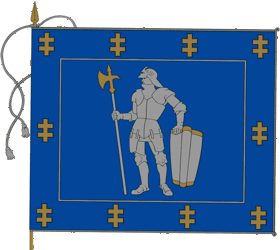
image by Virginijus Misiunas, 16 October 2009

Last modified: 2014-04-11 by zoltán horváth
Keywords: lithuania | alytus |
Links: FOTW homepage |
search |
disclaimer and copyright |
write us |
mirrors

image by Virginijus Misiunas, 16 October 2009
See also:
Municipalities:
The flag and the coat of arms of Alytus county - Alytaus
apskritis. Coat of Arms at <www.alytus.aps.lt>.
All county flags and Coat of Arms adopted on 2004 by Heraldic
Commission of Lithuanian Department of Interior.
Jens Pattke, 26 February 2005
A picture of the flag is shown here
and here.
Jens Pattke, 6 June 2009
The charge must be on blue canton. The double crosses are not
Lorraine (patriarchal) cross but its loca variant Jogaila cross,
i.e. with equal crosspieces.
The county covers the majority of Dzukija ethnic region,
including the Dzukian capital Alytus city. Therefore the arms of
Dzukija is granted to the county: on blue the silver
unmounted knight with halberd and Baltic shield.
Flag proportions 5:6, free edges bordered with silver
rope, finial is golden lance head with silver bands.
The charge originates in mid 14th century as the arms of Trakai
dukes: on red the silver unmounted knight with sword
and Baltic shield. That should mean the second
(sub-monarch's) position of Trakai duke in the feudal
hierarchy of Grand Duchy of Lithuania.
Distinguishing the arms of duke and land, in late 14th century
the knight of Trakai duchy held a lance and shield with
"Gediminas gate" badge. That variant is used by Trakai
District now (do not confuse it with the Trakai town, which
uses arms and flag with John Baptist's head).
In 17th century the variant with halberd appeared. During the
administrative reform of 1562-1564 a few districts
"pavietas" were established in the Trakai province
(former duchy). The core Trakai district was the crucial
factor for the formation of Dzukija ethnic region: they are
virtually the same area. Therefore the late variant of Trakai
province arms was appointed to Dzukija. Blue is the
traditional colour for the flags and battle banners of Trakai
province. So it was chosen for background of arms and flag. The
blue border with 10 Jogaila crosses is a common element for all
counties of Lithuania: the border means dependence, the Jogaila
cross means Lithuania, and 10 means the number of counties.
Colours golden on blue are traditional for Jogaila cross in
Lithuanian heraldry.
Virginijus Misiunas, 16 and 18 October 2009